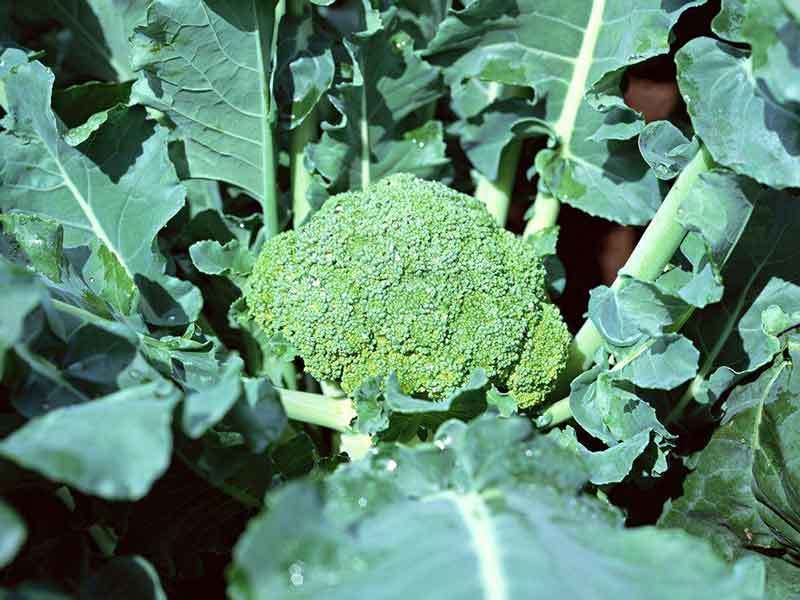Broccoli Leaves Turning Purple: Causes and Solutions
Introduction
Broccoli leaves turning purple can mean a range of things. Understanding the reasons behind this shift is key to managing your garden effectively. We will offer tips for a healthier broccoli crop.
Why Are My Broccoli Leaves Turning Purple?
Nutrient Deficiencies
Broccoli, much like us, needs a balanced diet. When key nutrients are lacking, it can lead to a condition known as chlorosis. It turns the leaves from green to purple. Two heavy hitters in the nutrient world are phosphorus and magnesium.
Phosphorus: This essential macronutrient plays a pivotal role in energy transfer, root development, and the synthesis of nucleic acids. A deficiency in phosphorus can manifest as stunted growth and purple leaves.
Magnesium: Part of the chlorophyll structure. Magnesium ensures your plant can undergo photosynthesis effectively. A deficiency can result in the purple discoloration of older leaves.
pH Imbalance in Soil
The acidity or alkalinity of your soil is measured on a pH scale. Different plants thrive within different ranges. Broccoli, for example, prefers a slightly acidic soil environment with a pH level between 6.0 and 7.0. Drifting beyond this comfort zone can impact nutrient availability.
Acidic Soil: A pH below 6.0 can lead to an iron deficiency. This can cause leaves to turn purple.
Alkaline Soil: Conversely, a pH above 7.0 can limit phosphorus availability. This can elicit a similar response.
Environmental Stressors
Extreme Temperatures: If temperatures are too low or too high, it may respond with broccoli turning purple. Cold temperatures can cause a purple tint due to an accumulation of sugars in the leaf tissues. The response can help protect the plant from freezing. High temperatures can lead to pigmentation. The plant tries to guard itself against sun damage.
Inadequate Sunlight: Sunlight is essential for photosynthesis, the process by which plants convert light energy into food. If your broccoli isn't getting enough sun, its leaves may turn purple as a result of reduced chlorophyll production.
Water Issues: Underwatering can lead to stress-related pigmentation. The plant will struggle to maintain its normal functions. On the other hand, overwatering can cause root rot due to lack of oxygen. This disrupts the plant's absorption of nutrients and water, leading to broccoli leaves turning purple and yellow.
Pest and Disease Infestations
Insect Damage: Aphids, caterpillars, and flea beetles are notorious for snacking on broccoli leaves. These insects can disrupt the plant's growth and nutrient uptake. This leads to purple or discolored foliage.
Fungal Infections: Fungal diseases can affect the color of broccoli leaves. For example, downy mildew or clubroot. These diseases interfere with the plant carrying out photosynthesis. The subsequent lack of chlorophyll can result in purple or yellowing leaves.

Diagnosing Purple Broccoli Leaves
Visual Cues
Visual diagnosis is often the first step in understanding why broccoli turns purple. Unlike the autumnal display of tree leaves, purple broccoli leaves are an indicator of stress rather than the changing seasons. This stress can arise from different sources. For example, nutrient deficiencies, extreme temperatures, or water stress.
Conducting Soil Tests
A simple soil test can reveal a wealth of information. Begin by checking the pH level. Broccoli prefer slightly acidic soil. If the pH is too high, it could be locking out necessary nutrients like phosphorus. Likewise, if the pH is within the correct range, examine macronutrient levels, especially phosphorus.
Inspecting for Pests and Diseases
Pests and diseases can also lead to broccoli leaves turning purple. For example, aphids or downy mildew. Inspect the entire plant, including the growing heads, for aphids or their tell-tale honeydew.
Similarly, look for signs of downy mildew on the undersides of leaves. For example, grayish spores. Taking prompt action here is critical. This can prevent further damage and spread throughout the garden.
Solutions and Remedies
Adjusting Soil pH
If the problem stems from acidic soil, adding lime to raise the pH. However, limestone can take several months to alter the pH. The reaction rates can vary drastically depending on the source and type of material. Opt for a fine-grained limestone to maximize surface area contact. Retest the pH 4-6 weeks after application for changes.
Nutrient Supplementation
Fast-acting remedies include foliar feeding with a phosphorus-based fertilizer. You can also apply a phosphorus-rich organic amendment. For example, bone meal. Look for a fertilizer with an N-P-K ratio that emphasizes phosphorus. For example, a 5-20-5 blend.
When choosing an organic amendment, consider the soil's biology. Products high in organic matter content provide a habitat and food for soil microorganisms. For example, compost or worm castings. They can unlock nutrients locked in your soil.
Environmental Management
Exposure to extreme heat or cold can trigger the production of anthocyanins. Use shading techniques to shield your plants from excessive heat. Consider row covers or cold frames to guard against frost.
Ensure your broccoli plants receive at least 6 hours of sunlight daily. Establish a consistent watering schedule, and be mindful of overwatering. It can lead to root rot. Similarly, check for soil moisture regularly. Adjust your watering practices accordingly.
Pest and Disease Control
Implement companion planting with insect-repelling herbs and flowers, to deter harmful insects. For example, basil and marigolds. Additionally, consider using natural predators, like ladybugs, to control aphid populations.
Utilize natural methods like neem oil or introduce beneficial insects to manage the pest population. You might need to resort to chemical controls if the infestation is severe. Always use pesticides and fungicides as directed. Opt for the least impactful options first to maintain the health of your garden ecosystem.
Conclusion
Why does broccoli turn purple? By understanding the root causes of broccoli leaves turning purple, you're already on the path to healthier plants. With the right tools, you can turn your purple problem into a green-thumb triumph.
When plant leaves change color, it often signals stress or care issues. Learn more in our common plant leaf problems guide.
Related Article:
can broccoli be grown in pots
pepper leaves turning purple

